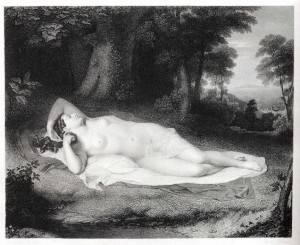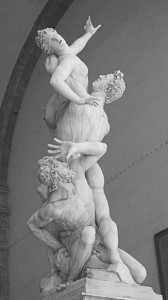Repeating the practice of releasing films from Hollywood’s golden age only at the end of a technology’s life cycle, Universal Studios recently released Lowell Sherman’s She Done Him Wrong (Paramount, 1933) on DVD. The plot centers on Lady Lou (played by Mae West), a hard-headed, tinsel-clad singer of Manhattan’s Bowery district in the 1890s who has climbed to the top of her profession by playing upon the desires and weaknesses of the roughnecks around her. Gus Jordan (Noah Beery, Sr.), owner of a popular saloon and an aspirant to public office, has entered into various shady schemes to keep her in diamonds; Dan Flynn (David Landau) is intent on usurping Jordan by informing the law of these illicit dealings, including a scheme to launder counterfeit bills aided by the spidery Russian Rita (Rafaela Ottiano) and her gigolo, Serge Stanieff (Gilbert Roland). The tale unfolds in a long, close space lined on one side by a high bar and on the other by a buffet surmounted by a large painting of Lou reclining naked on a grassy knoll and lifting her arms skyward. Alternately masked and exposed by the men milling before it, the picture becomes the focus of several discrete conversations about Lou’s beauty and desirability. The chatter subsides as Lou enters through the adjoining concert hall, covered in diamonds and lace and trailed by a liveried coachman piled with packages. Rotating hips and eyes, she entices the handsome Stanieff with some risqué cartes de visite. “Oh, wanna see the pictures?” she purrs. “Hmm, they are wonderful,” he responds, “but…uh…I like best that marvelous painting of you in the bar.” “Oh yeah, I gotta admit that is a flash, but I do wish Gus hadn’t hung it up over the…free lunch.” In this way, Lou colludes in perpetuating the image of a great beauty obtained at high price.
It is rare for an art object to play such a significant, character-enhancing role in the opening frames of a movie, though artifacts were regularly anthropomorphized in films of the 1930s and ‘40s: a portrait ages and disfigures in concert with its referent’s grizzly deeds; a clock ticks away the minutes as a jealous suitor makes his way to a dame’s bedroom with a shotgun; a staircase slows a mute servant’s descent to a dark cellar inhabited by a strangler.
Robert Usher, who served as art director on She Done Him Wrong, probably contracted out the job of preparing a painting of Mae West in the guise of an awakening Venus. Although the picture has little resemblance to her (beyond blond hair, fulsome bosom and hips), it does reference two well-known images from the realm of high art: John Vanderlyn’s Ariadne Asleep on the Island of Naxos (1805-1812) and Giovanni Bologna’s Rape of the Sabine Woman (1583), accessible via period prints, contemporary illustrated books, and travel photos.
Admiring the clear draftsmanship and ancient themes of third generation French neoclassicists while studying in Paris during the Napoleonic period, American Vanderlyn painted Ariadne asleep on a patch of grass at the edge of a stream, the gentle undulations of her body accentuated by the soft folds of an immaculate chiton and scarlet himation, which serve as her bedding, and her hands entwined in dark hair to suggest a state of erotic availability and post-coital ecstasy. At upper right, an opening in the grove reveals diminutive figures at the edge of the island, including Theseus, abandoning the princess who had helped him escape the Cretan labyrinth and now preparing to return to his king-father in Athens. Despite the prestige conferred on the composition by reference to Renaissance precedents, the nude was crafted for the delectation of a bourgeois white male audience and thus reinforced gender prescriptions for passive, exploitable women and active, controlling men; nevertheless, it scandalized viewers on its appearance in New York in 1815, and it did poor business as an Asher B. Durand engraving in 1835.
Whereas Vanderlyn’s painting makes the female the object of male sexual fantasies, Giambologna’s sculpture shows the former resisting the latter’s advances. A transplant to Florence in the second half of the sixteenth century when the late Mannerist style of Michelangelo prevailed, Fleming Giambologna (Jean de Boulogne) aimed at freeing his tightly knit sculptural groups from the linear harmonies and singular viewpoint of much Renaissance sculpture. Three nude figures pulsating with muscular energy are caught in a corkscrew motion: a crouching man covers his eyes in shock as a stronger rival strides over him bearing aloft his wife, crying and flailing in desperation. The work was completed in 1583 and Grand Duke Francesco de’ Medici ordered it installed in the Piazza della Signoria (near Cellini’s bronze of Perseus holding aloft the head of Medusa), where it evoked various abduction narratives—Phineus and Andromeda, Paris and Helen, Pluto and Persephone, and most enduringly, the Romans and the Sabines. In all of these narratives, the woman is an object of exchange between two men, a well-worn metaphor for the conquest of territories and the signing of treaties, but Giambologna permits the woman a measure of physical and psychological resistance, albeit elegant and ineffectual.
It is worth considering how these traditional modes for representing female sexuality may have changed in the early twentieth century. Mae West not only authored the successful Broadway stage play, “Diamond Lil,” but also took advantage of Paramount Pictures’ declining box-office sales to forward her titillating property, to adapt the dialog to a screenplay, to inflect the most innocuous words and movements with sexual innuendo in her performance, and thereby to establish herself as the preeminent vamp and voluptuary of the Great Depression. As Lady Lou comforts Sally Glynne, tempted to suicide after being compromised by a married man: “Men’s all alike, married or single. It’s their game. I happen to be smart enough to play it their way. You’ll come to it.” In other words, a woman’s survival depends on her ability to manage men’s expectations, masking her own desires with agreeable femininity. It is in this sense that the film’s wide-angle view of the saloon painting should be understood: ogled by three men, the nude’s pelvis is blocked by the central figure’s high bowler hat, suggesting both male arousal and forbidden access; similarly, the nude’s heavy eyelids and raised arms simultaneously evoke an inaccessible world of inner thoughts and dreams and a secret lover waiting beyond the picture plane. Thus, the image signifies “Lou” in a way that appeals to the barmen’s view of themselves as the stronger, more potent breed and masks the songstress’ own backstairs intrigues in pursuit of material and sexual gratification. The Hayes Code was enacted soon after to discourage such subversive ideas.
In times of war and recession, audiences tend to look back on their grandparents’ day with a sense of nostalgia. For theater-goers in the 1930s, this meant returning to the gay nineties, which offered the pleasing illusion of material surfeit and gender stability, of ruddy gentlemen eager to prove themselves as providers through equal measures of brain and brawn, of prim ladies sensuously padded and emotionally vulnerable in compliance with his projections. Mae West herself relied on this vision in turning it on its head. In a way she could not have predicted, the cultural pendulum has now swung the other way, towards a frank admission of gender instability: as women consolidate professional and/or domestic gains, men struggle to establish positive and comfortable identities, their own desires and feelings long masked by the duties of “husband and provider” and “benevolent patriarch.” The unapologetically self-aware male is ready to emerge in all his complexity and contradiction.


